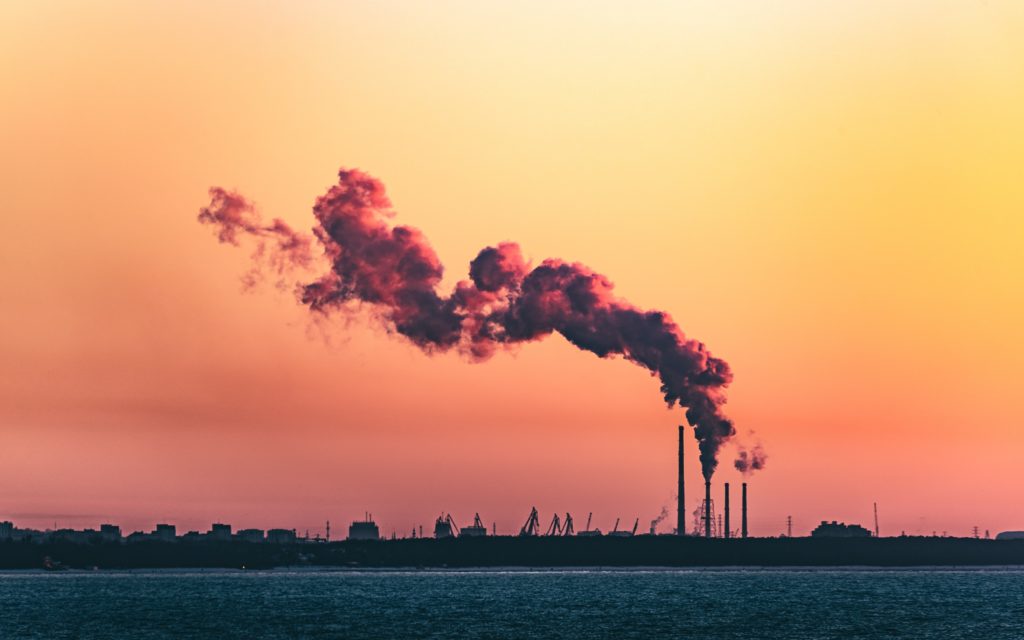Climate Now Episode 69
September 20, 2022
Follow the carbon trail: quantifying a corporate carbon footprint
Featured Experts

Charles Cannon
Manager, Climate Intelligence, RMI

Charles Cannon
Manager, Climate Intelligence, RMI
Charles is a Manager with RMI’s Climate Intelligence program, working at the intersection of environmental reporting, technology, and industrial decarbonization. Charles oversees a team that improves disclosure and exchange of GHG data in mining, metals, fuels, and electricity by developing impact-based reporting guidance. By developing a community of practice across NGO, governmental, and corporate practitioners, Charles works within RMI’s Horizon Zero team to close the ambition action gap between corporate sustainability goals and emissions reduction.
Before joining RMI, Charles went to school for mechanical engineering at Stevens Institute of Technology and worked as an engineer for a solar company, designing 50MW+ of commercial & industrial solar projects across the US.
In this Episode
Calls for transparent information on the carbon footprint of a product, service, company or government are getting louder from consumers and investors, and will likely be soon codified in regulations like the U.S. Securities and Exchange Commission’s proposed rule on climate risk reporting for publicly traded companies. But how do you actually account for all the emissions released in the production process or in a company activity? Is it even possible to accurately quantify?
Charles Cannon, a manager of RMI’s climate intelligence program, investigates ways to improve the quality of product level greenhouse gas information (like how much CO2 was released to manufacture your new refrigerator?). He sat down with Climate Now to explain the challenges involved in carbon accounting – the term for quantifying greenhouse gas emissions – and how those challenges might be addressed.
Related Media:


Climate Now: Apr 12, 2022
Climate risk reporting: Why an SEC mandate makes sense
The U.S. Securities and Exchange Commission wants to standardize climate risk reporting. What does that mean? On March 21, 2022 the SEC released a proposal for a new rule: that publicly traded companies will have to provide disclosures about how the changing


Climate Now: Nov 22, 2021
How to Ensure Climate Impact Investing Actually Has an Impact with Amit Bouri
“The [investment market] we have in place now is not working for people, it’s not working for the planet, and it’s actually not working for most investors.” This is according to Amit Bouri, Co-founder and CEO of the Global Impact Invest


Mini Explainer Series Ep 01
Scope 1, 2, and 3 Emissions
Companies assessing their greenhouse gas emissions will need to analyze their Scope 1, Scope 2, and Scope 3 emissions. This Climate Now mini provides a brief explanation of what that means.


Climate Now: Sep 7, 2021
Calculating Climate Financial Risks with Tory Grieves
The climate crisis has myriad effects on American businesses, from where properties are located and their likelihood of encountering extreme weather, to where materials are sourced and potential supply-chain complications. These effects inevitably carry with t


Climate Now: Sep 24, 2021
Climate impacts profits: How businesses should report climate risk with Emily Wasley
For businesses, a changing climate is not just about worsening weather patterns. Businesses must be prepared for what is likely to be an era of rapidly accelerating change to many dimensions of their operations, including changes in shareholder expectations, s
Episode Transcript
TRANSCRIPT
Follow the carbon trail: quantifying a corporate carbon footprint
with Charles Cannon, from RMI
Introduction
James Lawler: Welcome to Climate Now, a podcast that delves into the scientific ideas, technologies, and policies that’ll help us address the global climate crisis and reach a net-zero future. I’m your host, James Lawler. Quick PSA: if you enjoy listening to this podcast, please consider leaving us a review and subscribing to our weekly newsletter via our website, at climatenow.com. We have a number of exciting in-person events this fall, and tickets and discounts are available to our subscribers through the newsletter.
Today, we’re diving into corporate carbon accounting with Charles Cannon, a solar systems engineer, among many other things, who now works in the climate intelligence program at RMI, formerly Rocky Mountain Institute, out in Colorado. Disclosing carbon emissions will become mandatory for publicly-traded companies following the approval of the new Securities and Exchange Commission rule, but what exactly does this mean, especially for big industrial supply chains that involve numerous inputs and products?
James Lawler: Thanks for joining us, Charles. Let’s start by having you tell us: what is the climate intelligence program at RMI, and what exactly is your role in it?
Charles Cannon: The climate intelligence team works to close the ambition-to-action gap in decarbonizing industrial supply chains. You know, there’s been a number of bold claims, commitments made to reduce emissions, but a corporate actor needs some practical tools and tips for how to measure and manage their supply chain emissions. And specifically, I manage the first work area in improving carbon accounting.
Carbon Accounting: A History
James Lawler: Can you give us some history of carbon reporting? At the corporate level, where did this start? How has it evolved to where we are today?
Charles Cannon: Happy to. And it’s interesting, one of the first international agreements on climate wasn’t about carbon at all, but on CFCs, or chlorofluorocarbons, that were contributing to a hole in the ozone layer in the ’70s and ’80s, and indeed, the Montreal Protocol in 1987 was one of the first international climate agreements that would regulate these CFCs, or refrigerants, that were damaging the ozone layer.
And so, following science that started in the ’70s, you know, and proceeded with a flurry of activity in the ’80s, the Montreal Protocol was signed, which regulates all of these harmful chemicals, and to date, is the only UN treaty to be ratified by the entire world or by every member country. But a year after the Montreal Protocol was signed, the Intergovernmental Panel on Climate Change (IPCC) that’s still functioning and publishing these annual reports, was established in 1988.
Following through the mid-90s, Rio in 1992 formed the United Nations Framework Convention on Climate Change (UNFCC). And then in 1997, the Kyoto Protocol was adopted asking countries to adopt policies and measures on climate mitigation, kicking off the wave of modern environmental reporting as we know it, that would really blossom in the early 2000s.
James Lawler: Okay. So, maybe set the stage for us to understand this world of carbon accounting, you know, types of information that can be discovered from supply chains, and how you deliver that?
Charles Cannon: Yeah, over the last 20 or so years from the signing of the Kyoto Protocol, through the signing of the Paris Agreement, standards have been developing the entire time. For the level of reporting that you are trying to engage around, whether it’s
– national,
– corporate,
– asset, or
– product level,
depending on the sector that you’re operating in, whether it’s steel or transportation or chemicals, and the perspective that you’re taking, be it that of a
– consumer trying to understand a product,
– a corporate trying to understand their whole boundary, or
– a banker or financer trying to assess climate risk;
for all of those categories, there’s probably a set of guidance or recommendations or standards that have come out over the last two decades. Navigating all of those to find some level of consistency and comparability is incredibly challenging. The decisions that a given company will need to make, within one standard, let alone choosing the complement of which to use, provides significant hurdles to getting the numbers right, and navigating changes as your business changes over the year.
Carbon accounting is complex. Where does a company start?
James Lawler: Yeah. Supply chains are so incredibly complex, right? For many companies. There’s so many different inputs, and things come from so many different places. How can we possibly measure with any degree of accuracy, the emissions associated with a complex industrial supply chain? So, let’s say a Fortune 1000 company, I don’t know, someone in an operations role, presumably—I’m tasked with carbon reporting for my business. Let’s say that I produce some kind of appliance, home appliance, like refrigerators. Let’s say that I’m in that business. So, I require a lot of different inputs, a lot of different materials. My product has a certain emissions profile when it’s operational in the home. Where, where on earth do I start?
Charles Cannon: It is a daunting question. I would say, [start by] looking at the consumer-facing manufacturer. And the first stop for many companies is the Greenhouse Gas Protocol, that separates
– Scope 1, your direct operational emissions,
– your Scope 2, emissions from your purchased electricity and fuels, and
– your Scope 3, your everything else, your upstream and downstream emissions. The Scope ones and twos of all the companies that you buy things from and all the companies that you sell things to.
Within those categories, what are the transportation emissions that you have? What are the emissions from materials that you purchase? Let me go through the Greenhouse Gas Protocol, look at these different categories of Scope 3, you know, look at the embodied emissions of materials that I purchase, and then go look at specific sectors to see if they have calculation guidance. That is, to see if my government has particular emissions factors or standards that they recommend using. And, can I call up my supplier? And, when we get into the conversation of best practices, building relationships with suppliers to be able to understand and get primary or measured data is so valuable and takes a lot of time when you have tens, hundreds, thousands, of suppliers.
From these categories, you can develop your Scope 1, 2, and 3 emissions, and you can put that in an annual sustainability report. You can use the Global Reporting Initiative to say how that information should be placed in a report, and that’s your corporate disclosure.
If you wanted to say “This fridge is green” or “This fridge contains ‘that much’ CO2” from its manufacturer or its operational emissions, that takes you from corporate accounting to product level accounting. And then you’re getting into life cycle assessment and environmental product declarations and, all sorts of different energy star certifications and things like that. That is its own rabbit hole to go down.
James Lawler: Now, in order to properly report on scope three emissions, wouldn’t you have to do that product level carbon accounting, or no?
Charles Cannon: Doing carbon accounting from the product level makes the most sense, because if you can take all of the products that you purchase, quantify those emissions, and then stack them up to a corporate level, that is a more robust and primary data-forward method. It’s our hope that in the future, these building blocks of information at the product level, can be stacked at a corporate level, but also passed through to a consumer, so that you know what you’re buying, and that you’re not standing in the aisle, looking at different brands of straws and scratching your head, but rather you can just see what is and make a decision that’s aligned with your values.
Carbon Reporting Best Practices
James Lawler: What are the companies that are doing this reporting really well, and what are they doing?
Charles Cannon: So, best practices, companies will:
– publish their calculation methods, the choices and justifications they made while navigating these decision trees and developing their figures;
– they engage their suppliers regularly, building relationships that allows them to use more primary data in scope three disclosure; and
– encourage their suppliers, or participants in the value stream, to also do this reporting, right?
I’ll give two, and differing, examples. The first being BHP, which is one of the largest mining companies on the planet, shows up regularly on lists of one of the top emitters in the world, both from an annual and a historical perspective. They publish a 30-page supplemental document on their calculation methodology for Scope 1, 2, and 3 emissions, and the very first page is a table of changes from the last cycle of reporting. They say, we’ve changed this number here, we’re evaluating this in this way, because challenges in Scope 3 reporting in particular, you can have a lot of double counting, you can not have a lot of information, and so they wanna say, this is our approach, and we want it to meet scrutiny, rather than just give you a number and say, don’t worry about it.
The second example I would name is a consortia of automakers that we work with named Catena-X. This includes a number of automakers and manufacturers like BMW or Daimler that are working with ourselves and other NGOs and other members of industry to develop a reporting rule book, to calculate the embodied emissions in car parts. This is sound best practice because as an industry, they’re looking at these complex decision trees of reporting and agreeing on a more consistent and comprehensive way to report.
There’s an example of an individual company publishing its methods and saying, this is how we’re trying to do it, but there’s also the example of leaning in as an industry coalition, so that you can have greater levels of comparability because that’s a big piece that we’re missing. We’re not even comparing different kinds of fruit.
James Lawler: So, it sounds like where we are today is that large companies are trying to disclose their emissions, but they face a labyrinth of standards and methodologies, and they have vastly different capabilities to do this internally, and different levels of ambition to do it internally. It’s sort of like large companies are publishing something, by and large, but the accuracy or usefulness of this thing varies dramatically. Is that fair, or would you qualify that?
Charles Cannon: I think that that is fair, and that it comes down to, in some ways, a lack of climate intelligence, a lack of actionable insights on the climate impact of products and transactions to understand what the best action is to take. And indeed, you know, the challenge that modern reporting faces is closing this ambition-action gap as quickly as possible.
James Lawler: And, how can we do that? Charles, tell us.
Charles Cannon: That is the work that our team is undertaking and that really we’re seeing a ground swell across environmental reporting of both corporate actors leaning in and wanting to understand this more, and the academic and NGO community trying to rise to this challenge.
I’ll give an example in the steel sector, as our team is just now publishing draft guidance for product level accounting in the steel sector. It starts from understanding what’s the behavior change that needs to happen in steel for decarbonization. As we look towards 2050 in the best of scenarios, we’re still making half of our steel with iron ore that we’re mining out of the ground, give or take. Scrap recycling for steel right now is already above 90 percent. We want to get it higher, but it makes sense to recycle steel, and using recycled steel is much less emissions-intensive than mining iron, or stripping the oxygen out of iron oxide, turning it into pig iron, etcetera. So, when we look at the behavior change, scrap is still gonna be around, we need to decarbonize ore-based steel production. Right?
If a company just bought the lowest carbon steel they could, they would buy scrap-based steel. And we know that a company buying scrap based steel is not the only thing that needs to happen to decarbonize the steel sector. We need to invest in hydrogen-based direct reduction, and other low-carbon steel production methods, to do that. And so, RMI’s reporting guidance provides how you calculate the percent of ore and scrap-based input in your steel so that when you are purchasing steel, you can see the emissions intensity from the scrap-based aspect of it and the ore-based aspect. And just to step one level deeper, very briefly, ore and scrap are generally used in combination for almost all steel-making processes.
If you’re making steel from iron ore, you actually use anywhere from 10 to 30 percent scrap in that process anyways. And so that’s part of the challenge, scrap and ore is used in a majority of steel making processes. How do you split that out and understand that investment is happening in the ore-based decarbonization, right? Or if it’s coming from scrap-based decarbonization, because it’s also a positive thing and, you know, it’s more cost-effective to reduce emissions by using more scrap. So, by moving through some calculation guidance, a purchaser can say, “this is the intensity from ore-based production and scrap-based production in the same steel product.”
James Lawler: And so that’s a tool in the toolbox of a steel purchaser to help them sort of drive accountability down their supply chain when it comes to decarbonizing their sources of steel?
Charles Cannon: Yeah, and direct investment, and to take those building blocks of product-level information that they’re getting from an upstream supplier, and integrate that into their corporate disclosure or into their own product disclosure, saying “this car part was made with this kind of steel.”
When you’re able to build those relationships that have primary data and have it move between parties in a consistent and reliable way, you get to have more of a narrative around decarbonization. And in these massive, metal smelters all over the world, there’s not a narrative around decarbonization. There’s a business that they’re running.
Best Practices Into The Future
James Lawler: What do you think, if you could sort of transport yourself 10 years into the future, or let’s say five years, we’ll be optimistic here, what do you think best practices with regard to carbon accounting look like? What will companies have to do at that point?
Charles Cannon: In a few years, it’s our hope that companies will have the tools and the knowledge to know what explicit questions to ask of their suppliers, to get detailed product-level information, and then pass that through to whoever is next in the chain for them, until it reaches a consumer. We want to see a percentage of primary data share represented alongside this product as it reaches market. We want to see that nutrition facts label come to life. This is the CO2 equivalence of this product, this has been calculated using 70% primary data, and you know, here’s a QR code, you can scan to learn more about the methods that got you there.
James Lawler: Does that exist yet? Is anyone doing that?
Charles Cannon: There’s a wide range of technology providers and traceability solutions out there that are all building towards this. I think what’s missing is, everyone can picture what a nutrition facts label looks like in their head right now. The specific text, height, and font, and all of those things, that level of consistency and comparability is what’s currently missing. Our role as a nonprofit is to drive adoption in this space and drive harmonization and comparability at the pace needed, so that when this is widespread, it’s actionable and comprehensible.
James Lawler: I think that’s something that historically RMI has been pretty good at is getting large companies to maybe be leaders on a particular initiative. Are any plans like that underway with some of the larger consumer manufacturers?
Charles Cannon: Yeah. So, under our project, Horizon Zero, RMI maintains a technical advisory group full of corporates from a wide range of sectors in which we work, including steel, aluminum, petrochemicals, because this is not an academic effort, given the pace in that five years ambitious timeline, it really needs to be an iterative process. And there are companies that have a small ambition, or the gap of ambition-to-action that they are trying to close is a tight one. There’s emissions reduction commitments that are three years away, five years away, eight years away, they need the tools to meet their targets.
James Lawler: Do you think we’ll see any large companies coming out anytime soon with these embodied carbon labels?
Charles Cannon: We’re already seeing it in a number of places. It comes down to, there’s a question of, if a steel company designs their low carbon product disclosure, evaluating the veracity and the comparability, it might be excellent and robust, but not provide any comparability to an aluminum claim that another company is making. And then if you’re an auto manufacturer buying steel, and aluminum, you have this individual claim that might be robust, but the contextualization within like this whole space of actors and claims is a challenge, though we are starting to see more of this kind of product level disclosure, environmental product declarations come out from more and more companies.
James Lawler: It seems like RMI would be in a good position to sort of draft an initial proposed label. Since you guys have so many ties to so many industries, and you understand these ideas putting forth a proposed, embodied carbon label.
Charles Cannon: Yeah. I mean, part of the work in us putting out steel guidance early, you know, in draft form for public comment is this is how we think you could calculate this in a way that would be valuable for you. We obviously have a wide range of industry conversations and workshops, but we don’t wait for consensus to publish because we’re trying to iterate at the pace, and I think there’s a tremendous opportunity between the academic and NGO community, and as we look towards the next COP and things like that, to look at this aspect of definition and of standardization in a place that you know is not going to be standardized anytime soon, really.
James Lawler: Mm right, right.
Charles Cannon: Like there are ISO standards that are being developed, there are regulations that are being developed, but when you look at the Paris Agreement, like getting the entire world on the same page with a level of detail and complexity is not going to happen overnight. How do we put out ideas and iterate on them at pace so that we can build towards that.
Re-cap
James Lawler: That was Charles Cannon, climate intelligence manager at RMI, talking to us about carbon accounting. There’s obviously a lot of work still to do as companies and governments strive to improve carbon accountability and carbon reporting.
That’s it for today’s episode. If you found this episode interesting, please subscribe to our weekly newsletter at climatenow.com, or leave us a review on Apple Podcast, or wherever you happen to listen. Our newsletter connects current news in the climate and energy space to our educational content to provide a deeper understanding of this rapidly changing space. On our website, climatenow.com, you’ll find dozens of conversations with experts and videos explaining key ideas related to the energy transition and climate science.
As always, we love to hear from our listeners. If you have any thoughts, email us at contact@climatenow.com. Thank you, and we hope you’ll join us for our next conversation.
Climate Now is made possible in part by our science partners, like the Livermore Lab Foundation. The Livermore Lab Foundation supports climate research and carbon cleanup initiatives at the Lawrence Livermore National Lab, which is a Department of Energy Applied Science and Research Facility. More information on the foundation’s climate work can be found at livermorelabfoundation.org.